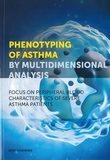Phenotyping of asthma by multidimensional analysis
Focus on peripheral blood characteristics of severe asthma patients

Hilvering, Bart
- Promoter:
- prof.dr. J.W.J. (Jan-Willem) Lammers & prof.dr. L. (Leo) Koenderman
- Co-promoter:
- dr. R.C. (Rene) Schweizer
- Research group:
- Koenderman
- Date:
- June 20, 2017
- Time:
- 10:30 h
Summary
In this thesis the activation state of blood eosinophils and neutrophils was discovered to contribute significantly to the diagnostic accuracy of a quick and low-invasive test for eosinophilia asthma. In patients with eosinophilic airway inflammation, blood eosinophils are more refractory to stimulation with fMLF.
A multi-dimensional reduction approach based on Non-linear PCA reduced dimensions of cellular and clinical parameters, making use of the multivariate advantage. Subsequent Discriminant Analysis of PCA scores of the Utrecht asthma cohort lead to a prediction model that was validated by the independently measured Oxford cohort of asthma patients. In contrast to blood, sputum eosinophils and neutrophils were found to be overall highly activated, independent of the asthma phenotype being eosinophilic or non-eosinophilic. Hence, sputum eosinophil and neutrophil activation do not have diagnostic value for asthma phenotypes.
In the subsequent two chapters, the MFC analysis method FLOOD was described. FLOOD identifies and describes subpopulations of cells that are changed or mobilized as a result of a stimulus. FLOOD showed its potential in the human LPS challenge study by clearly visualizing two subpopulations in an unsupervised fashion that were already known to be present but were not yet described in so much detail regarding specific receptor profile. FLOOD also identified exercise-associated neutrophils in elite rowers after intense anaerobic exercise. The exercise-associated neutrophils show similarities to banded cells appearing after LPS challenge. Additional functional assays (e.g. bacterial killing capacity) will be required to verify whether these neutrophils are in fact similar.
DAMACY, a second multivariate MFC analysis method, proved helpful in diagnosing asthma in general and eosinophilic asthma specifically. Moreover, it identified an important unknown subset of CD3+CD8+CRTH2+ cells, known to be Tc2 cells. In the last chapter of this thesis Tc2 cells are found to be present in higher numbers in peripheral blood and airways of patients with severe eosinophilic asthma. In vitro assays show an activation response of Tc2 cells by PGD2 and LTE4, both lipid mediators that were measured in higher concentrations in the airways of patients with severe eosinophilic asthma. Therefore Tc2s might play an important role in severe eosinophilic asthma and could be a promising target of therapy.
In summary, this thesis shows that a combination of detailed cellular measurements and improved multi-dimensional and unbiased analysis methods of MFC data lead to the development of promising diagnostic steps to further phenotype asthma with the ultimate goal to improve asthma care.